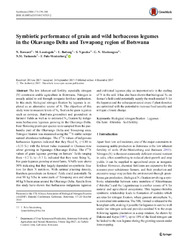| dc.contributor.author | Bernard, N. | |
| dc.contributor.author | Losologolo, M. | |
| dc.contributor.author | Batlang, U. | |
| dc.contributor.author | Ngwako, S. | |
| dc.contributor.author | Mashungwa, G. N. | |
| dc.contributor.author | Tselaesele, N.M. | |
| dc.contributor.author | Pule-Meulenberg, F. | |
| dc.date.accessioned | 2020-06-18T08:03:24Z | |
| dc.date.accessioned | 2021-03-15T09:19:17Z | |
| dc.date.available | 2020-06-18T08:03:24Z | |
| dc.date.available | 2021-03-15T09:19:17Z | |
| dc.date.issued | 2017 | |
| dc.identifier.citation | Bernard, N., Losologolo, M., Batlang, U., Ngwako, S., Mashungwa, G. N., Tselaesele, N. M., & Pule-Meulenberg, F. (2018). Symbiotic performance of grain and wild herbaceous legumes in the Okavango Delta and Tswapong region of Botswana. Symbiosis, 75(3), 179-188. | en_US |
| dc.identifier.issn | 1878-7665 | |
| dc.identifier.uri | https://link.springer.com/article/10.1007/s13199-017-0515-2 | |
| dc.identifier.uri | http://moodle.buan.ac.bw:80/handle/123456789/245 | |
| dc.description | Main article | en_US |
| dc.description.abstract | The low inherent soil fertility, especially nitrogen (N) constrains arable agriculture in Botswana. Nitrogen is usually added to soil through inorganic fertilizer application. In this study, biological nitrogen fixation by legumes is explored as an alternative source of N. The objectives of this study were to measure levels of N2 fixation by grain legumes such as cowpea, Bambara groundnut and groundnut in farmers’ fields as well as to estimated N2 fixation by indigenous herbaceous legumes growing in the Okavango Delta. Four flowering plants per species were sampled from the panhandle part of the Okavango Delta and Tswapong area. Nitrogen fixation was measured using the 15N stable isotope natural abundance technique. The δ15N values of indigenous herbaceous legumes indicated that they fixed N2 (−1.88 to +1.35 ‰) with the lowest value measured in Chamaecrista absus growing in Ngarange (Okavango Delta). The δ15N values of grain legumes growing on farmers’ fields ranging from −1.2 ‰ to +3.3 ‰ indicated that they were fixing N2. For grain legumes growing at most farms, %Ndfa were above 50% indicating that they largely depended on symbiotic fixation for their N nutrition. With optimal planting density, Bambara groundnuts on farmers’ fields could potentially fix over 90 kg N/ha in some parts of Tswapong area and about 60 kg N/ha in areas around the Okavango Delta. Results from this study have shown that herbaceous indigenous legumes and cultivated legumes play an important role in the cycling of N in the soil. It has also been shown that biological N2 on farmer’s field could potentially supply the much needed N for the legumes and the subsequent cereal crops if plant densities are optimized with the potential to increase food security and mitigate climate change. | en_US |
| dc.language.iso | en | en_US |
| dc.publisher | Springer Verlag | en_US |
| dc.relation.ispartofseries | Symbiosis;Vol. 75 (3) 2018 | |
| dc.subject | Biological nitrogen fixation | en_US |
| dc.subject | Legumes | en_US |
| dc.subject | On-farm | en_US |
| dc.subject | Rhizobia | en_US |
| dc.subject | Soil fertility | en_US |
| dc.title | Symbiotic performance of grain and wild herbaceous legumes in the Okavango Delta and Tswapong region of Botswana | en_US |
| dc.type | Article | en_US |

